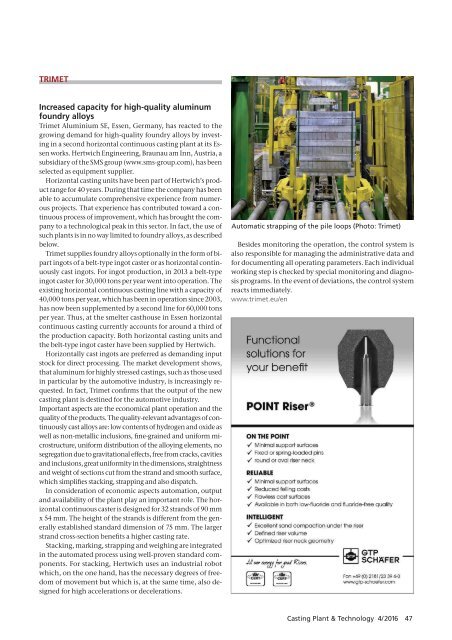CPT International 04/2016
The leading technical journal for the global foundry industry – Das führende Fachmagazin für die weltweite Gießerei-Industrie
The leading technical journal for the
global foundry industry – Das führende Fachmagazin für die
weltweite Gießerei-Industrie
Create successful ePaper yourself
Turn your PDF publications into a flip-book with our unique Google optimized e-Paper software.
TRIMET<br />
Increased capacity for high-quality aluminum<br />
foundry alloys<br />
Trimet Aluminium SE, Essen, Germany, has reacted to the<br />
growing demand for high-quality foundry alloys by investing<br />
in a second horizontal continuous casting plant at its Essen<br />
works. Hertwich Engineering, Braunau am Inn, Austria, a<br />
subsidiary of the SMS group (www.sms-group.com), has been<br />
selected as equipment supplier.<br />
Horizontal casting units have been part of Hertwich’s product<br />
range for 40 years. During that time the company has been<br />
able to accumulate comprehensive experience from numerous<br />
projects. That experience has contributed toward a continuous<br />
process of improvement, which has brought the company<br />
to a technological peak in this sector. In fact, the use of<br />
such plants is in no way limited to foundry alloys, as described<br />
below.<br />
Trimet supplies foundry alloys optionally in the form of bipart<br />
ingots of a belt-type ingot caster or as horizontal continuously<br />
cast ingots. For ingot production, in 2013 a belt-type<br />
ingot caster for 30,000 tons per year went into operation. The<br />
existing horizontal continuous casting line with a capacity of<br />
40,000 tons per year, which has been in operation since 2003,<br />
has now been supplemented by a second line for 60,000 tons<br />
per year. Thus, at the smelter casthouse in Essen horizontal<br />
continuous casting currently accounts for around a third of<br />
the production capacity. Both horizontal casting units and<br />
the belt-type ingot caster have been supplied by Hertwich.<br />
Horizontally cast ingots are preferred as demanding input<br />
stock for direct processing. The market development shows,<br />
that aluminum for highly stressed castings, such as those used<br />
in particular by the automotive industry, is increasingly requested.<br />
In fact, Trimet confirms that the output of the new<br />
casting plant is destined for the automotive industry.<br />
Important aspects are the economical plant operation and the<br />
quality of the products. The quality-relevant advantages of continuously<br />
cast alloys are: low contents of hydrogen and oxide as<br />
well as non-metallic inclusions, fine-grained and uniform microstructure,<br />
uniform distribution of the alloying elements, no<br />
segregation due to gravitational effects, free from cracks, cavities<br />
and inclusions, great uniformity in the dimensions, straightness<br />
and weight of sections cut from the strand and smooth surface,<br />
which simplifies stacking, strapping and also dispatch.<br />
In consideration of economic aspects automation, output<br />
and availability of the plant play an important role. The horizontal<br />
continuous caster is designed for 32 strands of 90 mm<br />
x 54 mm. The height of the strands is different from the generally<br />
established standard dimension of 75 mm. The larger<br />
strand cross-section benefits a higher casting rate.<br />
Stacking, marking, strapping and weighing are integrated<br />
in the automated process using well-proven standard components.<br />
For stacking, Hertwich uses an industrial robot<br />
which, on the one hand, has the necessary degrees of freedom<br />
of movement but which is, at the same time, also designed<br />
for high accelerations or decelerations.<br />
Automatic strapping of the pile loops (Photo: Trimet)<br />
Besides monitoring the operation, the control system is<br />
also responsible for managing the administrative data and<br />
for documenting all operating parameters. Each individual<br />
working step is checked by special monitoring and diagnosis<br />
programs. In the event of deviations, the control system<br />
reacts immediately.<br />
www.trimet.eu/en<br />
Casting Plant & Technology 4/<strong>2016</strong> 47


















